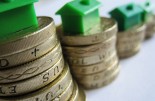AXA IM: Climate risk in real estate
AXA IM: Climate risk in real estate

The real estate sector represents about 38% of energy consumption and 29% of all greenhouse gas emissions in the EU1. The sector therefore has a very important role to play in our combined effort to combat climate change and to work towards the 1.5° path as set out in the Paris Agreement.
By Timothée Rauly, Global Co-Head Real Estate, AXA IM Alts
The goal to be net zero by 2050
As the knowledge in the market grows, so does the understanding of the magnitude of the challenge we face. The emissions from our assets are now expanding to include both operational emissions, the emissions from the day-today use of our assets, and embodied emissions, or those emissions which result from the materials used in the creation or refurbishment of our assets.
As asset managers, it’s important to recognise that when we talk about net zero, there are some limitations on what can be delivered. For example, while we can actively invest in more energy efficient buildings, or build lower-carbon developments, there are limitations as to how much control can be placed on the performance or operations of our tenants. Similarly, very few managers have a mandate to acquire carbon offsets on behalf of their clients, for example, to deal with hard to abate emissions such as those from refrigerants.
Within our organisation, we focus on how we can invest to improve asset performance, to make sure that we can drive energy efficiency and that we can reduce the overall emissions of that particular asset, regardless of location or type. But it is equally important to articulate the remaining carbon ‘liability’ to be addressed with the asset owner and client.
The current renovation rate in Europe is far too slow to meet the Paris targets. Furthermore, at some point carbon costs must be passed on into the economy.
The reduction of operational carbon emissions is often focused around improving energy efficiency of existing assets, for example through better insulation or smarter systems, and through the change of fuel source, from fossil fuel to low carbon alternatives, such as through the installation of renewable energy on site, or the replacement of gas boilers with electric heat pumps. Additionally, emission reductions can also be achieved by incentivising and educating tenants on more efficient energy usage.
Often overlooked, however, are the embodied emissions resulting from the materials used to build or refurbish assets, such as cement and steel. This can also include the transportation of these materials from extraction to end use.
While energy efficiency of buildings has increased over the last decades, much more emphasis will have to be placed on embodied carbon emissions.
While energy efficiency of buildings has increased over the last decades, much more emphasis will have to be placed on embodied carbon emissions for the sector to be able to be net zero by 2050. Because embodied emissions are significantly larger for new developments than for retrofits and refurbishments, we expect a significant increase in more energy efficient retrofits will be necessary to meet global growth requirements.
The regulatory environment
On a European level there is much discussion about reallocating capital toward decarbonisation and meeting the Paris targets, but limited discussion on the necessary regulation to support the transition from brown to green real estate to help direct capital into refurbishing existing assets. This concerns most of the existing assets we will own and manage between now and 2050. The current renovation rate in Europe is far too slow to meet the Paris targets. Furthermore, at some point carbon costs must be passed on into the economy. The real estate sector is beginning to AXA IM anticipate this, but there are few organisations that are currently engaged in discussions with regulatory bodies about this. Given the scale of emissions associated with the sector, it is likely that we will see increasing regulatory intervention in this space.
Often overlooked are the embodied emissions resulting from the materials used to build or refurbish assets.
The role of climate risk tools
Climate risk tools are used to predict future impact on investments. The number of available tools is growing, which is positive, but it is also dangerous to take them as certain, as they are still in early phases. CRREM, Carbon Risk Real Estate Monitor, is a great example. It’s an EU-funded research project that sets Parisaligned, science based energy use and carbon emission intensity targets for each year to 2050, by asset class and geographic location. It is one of the great enabling tools for our industry to align around a common goal, but depending on underlying assumptions (for instance normalisation for office hours, green power procurement, access to data, or lack thereof) there are vastly different outputs which could impact decision making.
Best practices for accelerating emission reductions
In Australia there are new innovations in grid interactive buildings being used to stabilise grids, utilise renewable energy and reduce building emissions, such as where buildings are preheated or pre-cooled with renewable energy outside peak hours, in advance of a heat wave or a particularly cold period. This shifts the demand profile so that there is a reduced demand for power generation during the hottest part of the day, reducing strain on the grid and minimising demand for peak power input. Integrating these types of systems with intelligent digital solutions is one of the best practices of the past year. The sooner these approaches can become mainstream, the greater the opportunity to benefit from what is, certainly in Europe, a very rapidly decarbonising grid.
1 Source : CRREM, as of July 2023.
|
SUMMARY By improving asset performance, investors can help drive energy efficiency forward and reduce overall emissions. The embodied emissions resulting from the materials used to build or refurbish assets is often overlooked. There is much discussion about reallocating capital toward net zero, but little discussion on the necessary regulation to support the energy transition. Climate risk tools and other solutions offer great opportunities for real estate investors. |
|
Disclaimer Source: AXA IM as of 31/07/2023. The information is estimated by AXA IM and is based on the investment team experience and current view of the market and is provided for illustrative purposes only. This marketing communication does not constitute, on the part ofAXA Investment Managers Paris a solicitation or investment, legal or tax advice. This material does not contain sufficient information to support an investment decision. Due to its simplification, this communication is partial and opinions, estimates and forecasts herein are subjective and subject to change without notice. There is no guarantee forecasts made will come to pass. Data,figures, declarations, analysis, predictions and other information in this document is provided based on our state of knowledge at the time of creation of this document. Whilst every care is taken, no representation or warranty (including liability towards third parties), express or implied, is made as to the accuracy, reliability or completeness of the information contained herein. Reliance upon information in this material is at the sole discretion of the recipient. Issued by AXA INVESTMENT MANAGERS PARIS, a company incorporated under the laws of France, having its registered office located at Tour Majunga–La Défense 9 –6, place de la Pyramide–92800 Puteaux, registered with the Nanterre Trade and Companies Register under number 353 534 506, and a Portfolio Management Company, holder of AMF approval no. GP 92-008, issued on 7 April 1992. In other jurisdictions this document is issued by AXA Investment Mangers SA’s affiliates in those countries. |










